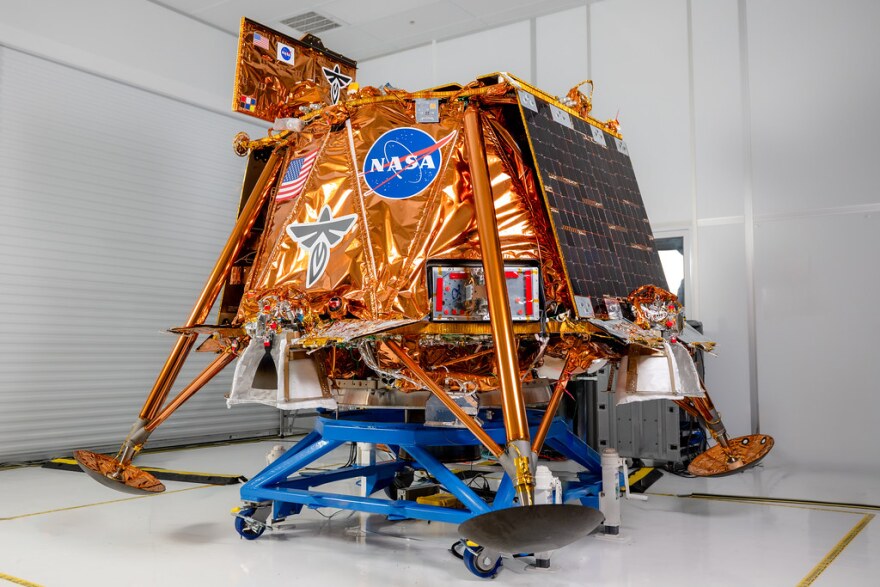How do you study our sun when it’s incredibly hot?
Our sun, a hot yellow dwarf star that’s about 4.5 billion years old, plays a crucial role in space weather and life here on Earth. But to study our sun, a spacecraft must withstand extreme temperatures.
Flying 3.8 million miles away from the sun’s surface, the Parker Solar Probe flew by our own star closer than any other human-made object and survived.
Equipped with an advanced heat shield and radiator system, the probe broke its own record for the closest flyby to the sun on Dec. 24, 2024.
Alex Young, the Associate Director for Science Communication and Heliophysics at NASA’s Goddard Space Flight Center, said by studying our sun and space weather, scientists can better understand life here on Earth.
One aspect of space weather we see on Earth is when the sun’s explosions of material and magnetic field cause aurora, or geomagnetic storms.
“Those electrical disturbances filter down into the upper atmosphere and excite oxygen and nitrogen, which those glow in particular colors and give us the aurora,” Young said. “The stronger that activity, the farther south you can see aurora. That activity is actually following a cycle on the sun. The cycle is roughly 11 years from low to high and back down to low. Right now, we are at the peak of that activity, what we call solar maximum.”
But when the sun is at that peak activity, things like radio frequencies and satellites can be disrupted or damaged. Young said it can be dangerous to astronauts, and in extreme cases, it can disrupt power grids.
“If space weather happens during a hurricane or a tornado or some sort of weather-related event it can disrupt the ability of those particular services to communicate,” Young said. “That's one of the main reasons why we really want to understand it and be able to ultimately predict it, much like we predict weather here on Earth.”
With the discovery of exoplanets orbiting other stars, scientists have wondered whether another star could help support life on far away planet. While the Parker Solar Probe will collect data from our solar system’s star, the evidence could help scientists better understand other stars.
“That's one of the things that's exciting about being able to take this kind of data,” Young said. “Because our sun is so close, we are able to study a star up close and personal. So, our Sun is like a laboratory, and we do extrapolate that data for all the other stars in the universe. You know, we've discovered 1000’s of exoplanets, basically solar systems, outside of our own.”
Ghost Rider is a go for launch
The moon is full of untapped knowledge, and NASA and partners like Firefly Aerospace are trying to get science equipment to the moon’s surface to better understand its makeup.
Firefly Aerospace’s Blue Ghost Mission 1 is targeting an early liftoff on January 15. It will take 45 days for the Blue Ghost Lunar Lander to get to the moon with ten payloads on board. These payloads will help study rock samples, space weather and the moon’s surface.
But this mission is just one of three moon missions from Firefly. Following the upcoming launch, the lander will journey to the lunar surface again in 2026 and in 2028.

Kevin Scholtes, the Future Systems Architect at Firefly Aerospace, said Blue Ghost Mission I is part of NASA’s Commercial Lunar Payload Services (CLPS) that aims to bring science equipment to the moon.
Scholtes said the aim of CLPS “is to help jump start a lunar economy and help create an environment in which there are robust commercial services that can support non-nation state interests in going to the moon and taking payloads to the moon,” Scholtes said. “NASA is taking the risk and leaning forward on the commercial aspect of the program by funding companies like ours to take their payloads to the moon on a commercial program.”
The lander will launch aboard SpaceX’s Falcon 9 rocket. The moon’s gravity will help pull the lander down to touch down on a part of the moon called the Mare Crisium to deliver the payloads.
When launching missions into space, it can be risky. But Scholtes said success can be measured in a lot of different ways, and so far, Firefly has already been successful in making this lunar lander.
“There are measures of success too, where every step of the way we're building success for the future of Blue Ghost, for the future of the CLPS program and for the future of the lunar economy,” Scholtes said. “So as soon as we get off the launch vehicle, we're already buying down risk on all three of those branches of the future.”
With two more missions after Blue Ghost’s first launch, Scholtes said he is eager to see how often the lunar lander can take payloads to the moon.
“When we get to the point where we are supporting active, permanent presence on the lunar surface, be it robotic presence that survives the night or human presence, then I think you're going to see a launch cadence that's probably measured in the high single digits to low double digits of launches per year in terms of support for efforts going to the moon directly,” Scholtes said. “That's my initial prediction, but I also know experientially that you cannot predict the future, so we'll see how it plays out, but I think if we saw that, that would be an incredible sign of success.”






